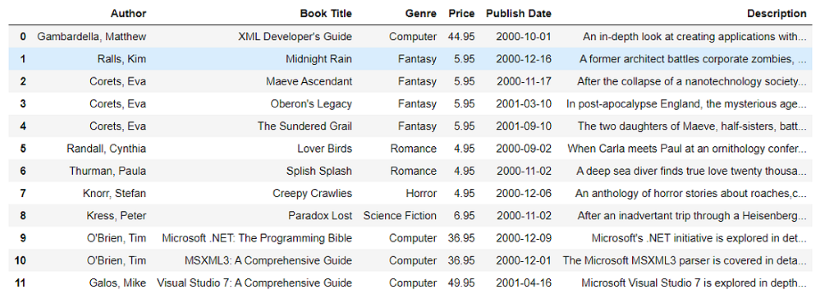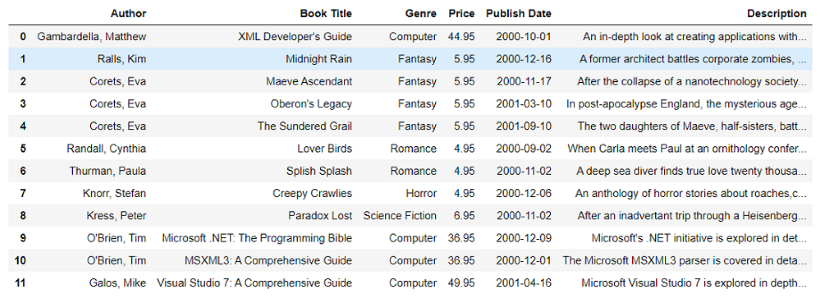使用BeautifulSoup将XML结构转换为DataFrame
在这里,我们将使用Python的BeautifulSoup包将XML结构转换为一个DataFrame。它是一个用于搜刮网页的Python库。要安装这个库,命令是
pip install beautifulsoup4
我们将使用这个库从XML文件中提取数据,然后我们将把提取的数据转换为数据框架。为了转换为Dataframes,我们需要安装panda的库。
Pandas库:它是一个用于数据处理和分析的python库。要安装这个库,命令是
pip install pandas
注意:如果它要求你安装一个分析器库,使用命令
pip install et_xmlfile
分步实现:
第1步:导入库。
from bs4 import BeautifulSoup
import pandas as pd
首先,我们需要导入将在我们的程序中使用的库。在这里,我们从bs4模块中导入了BeautifulSoup库,还导入了pandas库并创建了它的别名 “pd”。
第2步:读取xml文件。
file = open("gfg.xml",'r')
contents = file.read()
在这里,我们使用open(“filename”, “mode”)函数以读模式 “r “打开名为 “gfg.xml “的xml文件,并将其存储在变量 “file “中。然后,我们使用read()函数读取存储在该文件中的实际内容。
第3步:
soup = BeautifulSoup(contents,'xml')
在这里,我们将存储在’contents’变量中的文件数据交给BeautifulSoup函数,同时传递文件的类型,即XML。
第4步:搜索数据。
在这里,我们正在提取数据。我们使用find_all()函数,该函数返回在该函数中传递的标签中存在的提取的数据。
authors = soup.find_all('author')
titles = soup.find_all('title')
prices = soup.find_all('price')
pubdate = soup.find_all('publish_date')
genres = soup.find_all('genre')
des = soup.find_all('description')
示例:
authors = soup.find_all('author')
我们要将提取的数据存储到author变量中。这个find_all(‘author’)函数将提取xml文件中author标签内的所有数据。这些数据将被存储为一个列表,即author是一个从该xml文件中所有author标签中提取的数据列表。其他语句也是如此。
第5步:从xml中获取文本数据。
data = []
for i in range(0,len(authors)):
rows = [authors[i].get_text(),titles[i].get_text(),
genres[i].get_text(),prices[i].get_text(),
pubdate[i].get_text(),des[i].get_text()]
data.append(rows)
现在,我们已经有了从xml文件中提取的所有数据,并按照标签放在不同的列表中。现在我们需要从不同的列表中合并与一本书有关的所有数据。因此,我们运行一个for循环,将不同列表中的某本书的所有数据存储在一个名为 “rows “的列表中,然后将每一行附加到另一个名为 “data “的列表中。
第6步:打印数据框架。
最后,我们有一个分离的每本书的组合数据。现在我们需要将这个列表数据转换成一个DataFrame。
df = pd.DataFrame(data,columns = ['Author','Book Title',
'Genre','Price','Publish Date',
'Description'], dtype = float)
display(df)
输出:

DataFrame
在这里,我们使用pd.DataFrame()命令将该数据列表转换为数据框架。在这个命令中,我们传递了列表 “data”,也传递了我们想拥有的列的名称。我们还提到了数据类型(type)为float,这将使所有的数字值都是浮动的。
现在我们已经使用BeautifulSoup从XML文件中提取了数据到DataFrame中,它被存储为 “df”。为了查看DataFrame,我们使用print语句来打印它。
使用的XML文件 – GFG.xml
以下是完整的实施方案:。
# Python program to convert xml
# structure into dataframes using beautifulsoup
# Import libraries
from bs4 import BeautifulSoup
import pandas as pd
# Open XML file
file = open("gfg.xml", 'r')
# Read the contents of that file
contents = file.read()
soup = BeautifulSoup(contents, 'xml')
# Extracting the data
authors = soup.find_all('author')
titles = soup.find_all('title')
prices = soup.find_all('price')
pubdate = soup.find_all('publish_date')
genres = soup.find_all('genre')
des = soup.find_all('description')
data = []
# Loop to store the data in a list named 'data'
for i in range(0, len(authors)):
rows = [authors[i].get_text(), titles[i].get_text(), genres[i].get_text(
), prices[i].get_text(), pubdate[i].get_text(), des[i].get_text()]
data.append(rows)
# Converting the list into dataframe
df = pd.DataFrame(data, columns=['Author',
'Book Title', 'Genre',
'Price', 'Publish Date',
'Description'], dtype = float)
display(df)
输出:

DataFrame
 极客教程
极客教程